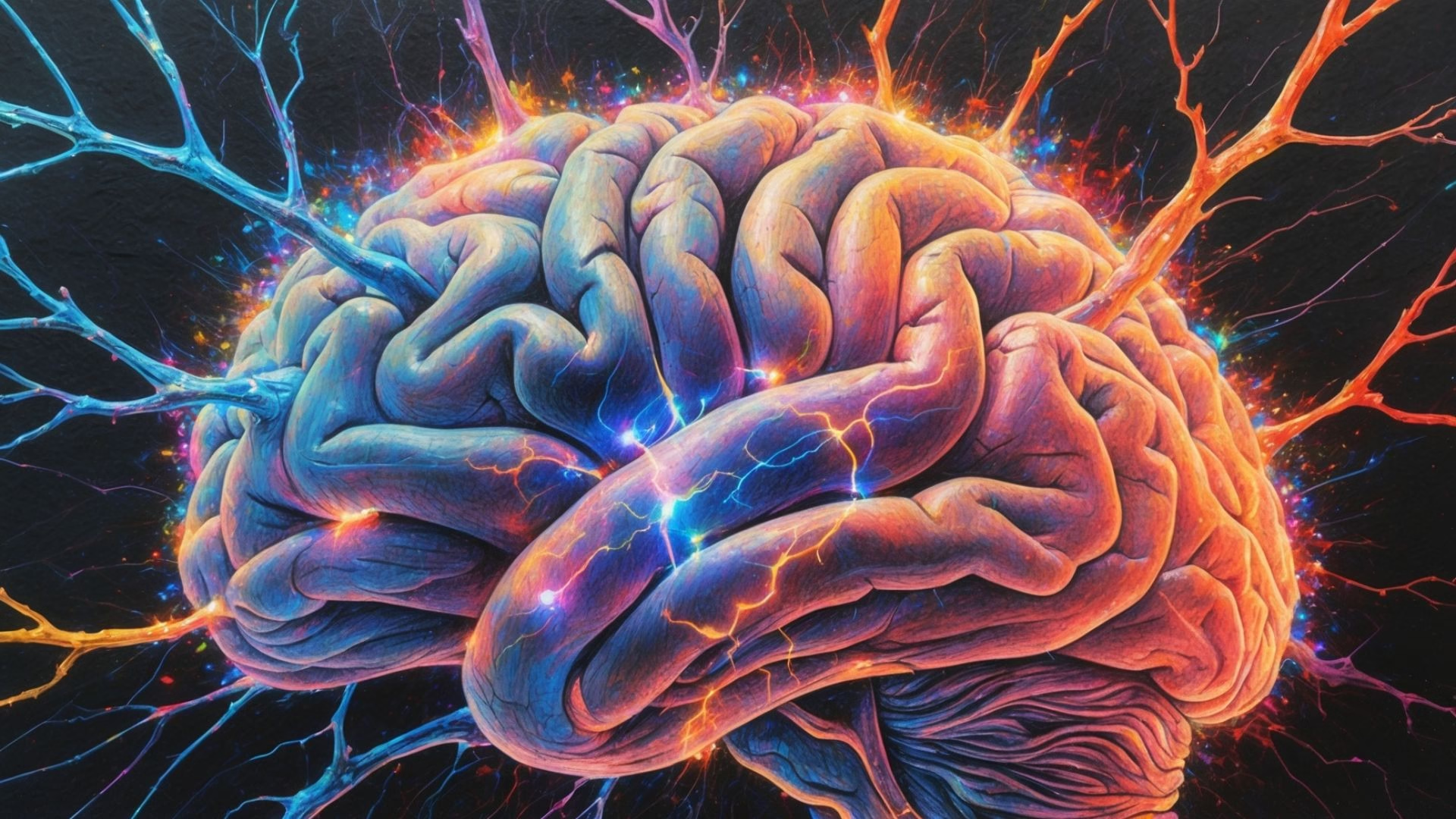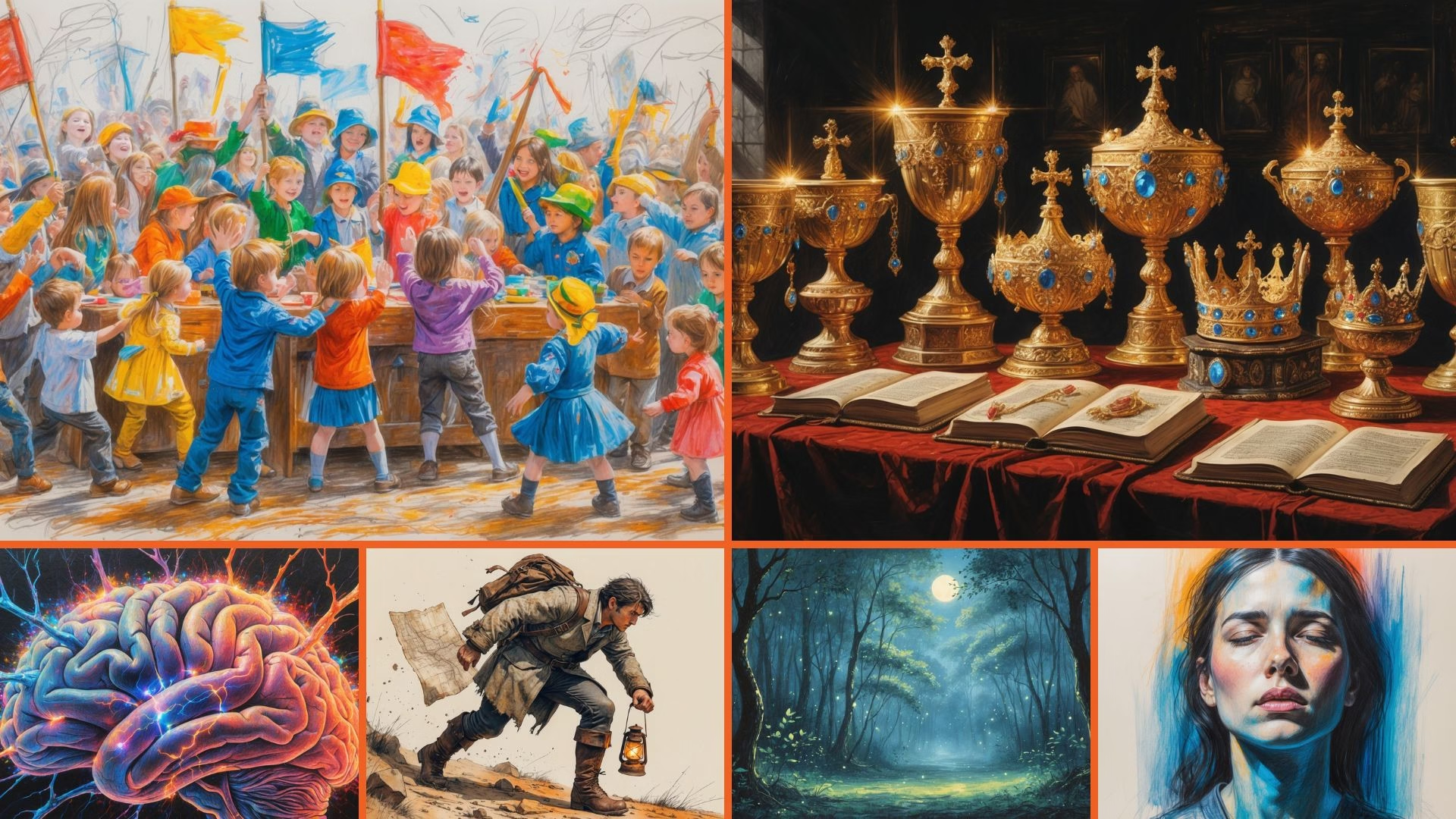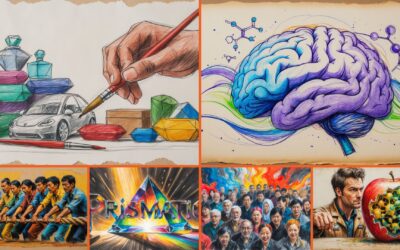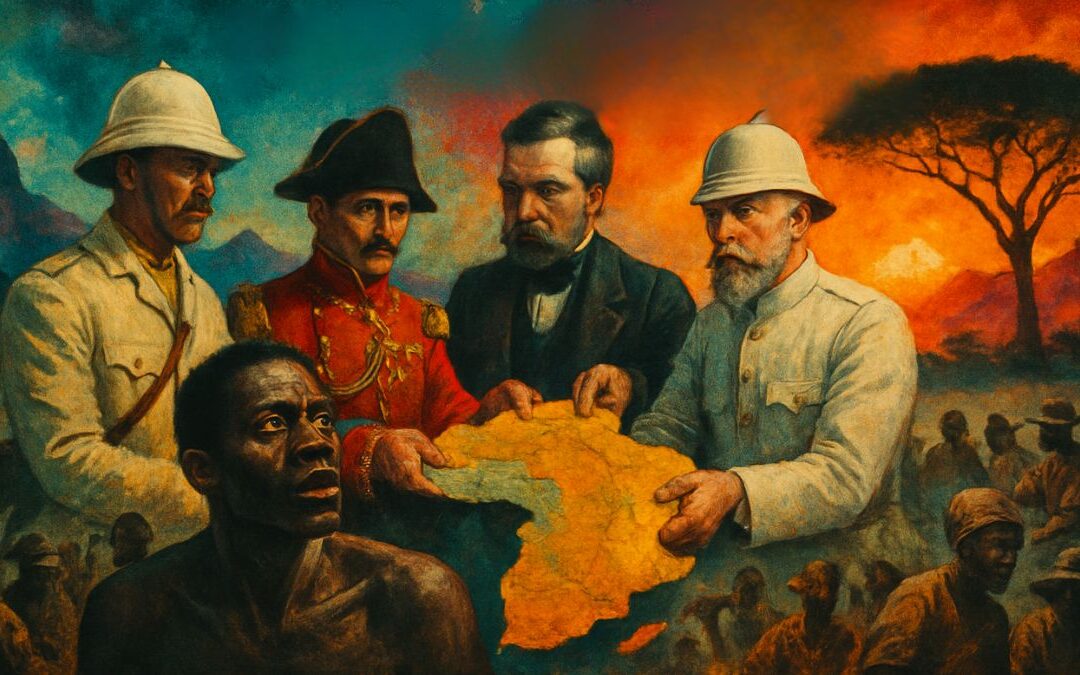- Podcast Episode
- Daily Expression | Leave no stone unturned
- Daily Question | If you could change one habit from your past, what would it be and how might it affect your present?
- What IF | What if society was run by children?
- Word of the Day | Glimmer
- Know Your Brain | Synapses: Where Brain Cells Communicate
- Unsolved Mystery | The Treasure of the Knights Templar
Podcast Episode
Daily Expression | Leave no stone unturned

So, let me ask you this: Ever lost your keys? Or maybe your phone? You know that feeling, right? That rising panic, followed by that methodical, slightly frantic search. You check your pockets for the tenth time, you rummage through the couch cushions, you peer under furniture… Have you ever felt like you were so close to finding something, and you just knew one more determined search would crack the case?
That intense, exhaustive search is exactly what we’re tapping into today with the expression: “Leave no stone unturned.” It sounds dramatic, doesn’t it? Like something out of an old detective movie. But what does it really mean, and how does this idea of flipping over every metaphorical rock play out in our lives?
Let’s break it down. Literally, imagine searching a field. If you’re truly determined to find something small, like a lost ring, you might actually start lifting rocks, one by one, to see if it’s hiding underneath. That’s the image: absolute thoroughness. No possibility overlooked.
Figuratively, which is how we almost always use it, “leave no stone unturned” means to try every possible course of action, explore every single option, investigate every clue, or search in every conceivable place to find something or achieve a goal. It speaks of diligence, persistence, and a refusal to give up until every avenue has been explored.
There’s a fascinating story about its origin, possibly linked to the ancient Greek playwright Euripides. Legend has it that after a battle defeat, a general sought guidance from the Oracle of Delphi on where to find hidden treasure left by the enemy. The Oracle supposedly advised him to “leave no stone unturned.” And guess what? He apparently did, searched meticulously, and found the treasure under a stone statue. Whether historically accurate or not, it paints a vivid picture, right? The idea of hidden value waiting to be discovered if only we look hard enough.
So, how do we use this in everyday life? Well, think about applying for a job. If you’re determined to land your dream role, you don’t just send one application and hope for the best. You leave no stone unturned: you research companies, network, tailor your resume for each specific role, practice interviewing, follow up diligently. You explore every angle.
Or maybe you’re planning a surprise party for a friend. Leaving no stone unturned means considering every detail: the guest list, the perfect location, the decorations, the food (allergies included!), the music, the element of surprise itself. You think through every potential snag to make it perfect.
Even troubleshooting a problem – why isn’t the internet working? You check the router, the cables, the modem, restart everything, call the provider… you exhaust all possibilities. You’re leaving no stone unturned in your quest for connectivity!
But let’s go deeper than just the practical application. What’s the power behind this phrase? I think it lies in the commitment it represents. It’s a statement of intent. It says, “I am fully invested in this. I will not be deterred by difficulty or the sheer effort required.” There’s a certain nobility in that level of dedication, isn’t there?
It also speaks to a kind of optimistic practicality. It acknowledges that the answer or solution might be hidden, it might be difficult to find, but it is findable. It implies that with enough effort and systematic searching, success is possible. It counters the feeling of helplessness. Instead of saying “I can’t find it” or “It’s impossible,” you say, “I haven’t looked everywhere yet.”
Think about the satisfaction that comes from knowing you truly gave something your all. Even if the outcome isn’t exactly what you hoped for, knowing you left no stone unturned brings a unique kind of peace. You didn’t quit halfway; you saw it through to the absolute end of possibility. There’s power in that closure.
It encourages us to be resourceful, to think creatively about where else we could look or what else we could try. It pushes us beyond the obvious paths. Maybe the ‘stone’ we need to turn over isn’t a physical object, but a conversation we’ve been avoiding, a skill we need to learn, or a perspective we haven’t considered.
So, this expression isn’t just about finding lost things. It’s about a mindset. It’s about tackling challenges with grit and determination. It’s about the pursuit itself, the journey of exploration, and the commitment to thoroughness. It’s about activating that inner detective, that problem-solver, that part of us that refuses to settle for ‘good enough’ when ‘everything possible’ is the goal.
Now, I want you to think about this: Think about a time you truly left no stone unturned in your own life. Maybe it was for a big project, a personal quest, or even helping someone else. What drove that intense dedication? And perhaps more interestingly, what did you discover in the process, even if it wasn’t exactly what you were initially looking for? Sometimes the discoveries made while turning over those stones are the real treasure.
I’d love to hear about your experiences with leaving no stone unturned. Share your stories and reflections in the comments section on the podcast, over on our website englishpluspodcast.com, or on our Patreon page. Let’s explore this together.
Daily Question | If you could change one habit from your past, what would it be and how might it affect your present?

Let’s play a little game of mental time travel today. No DeLorean needed, just your imagination. Okay, picture this: You get a one-time-only, no-backsies opportunity to reach back into your own past and tweak one single habit. Just one. Maybe it’s a habit you had as a teenager, or one from just a few years ago. Poof! It’s gone, replaced, or altered. The question is: If you could change one habit from your past, what would it be, and perhaps more intriguingly, how do you imagine that change might ripple outwards and affect your present life, right here, right now?
It’s a tempting thought, isn’t it? The idea of smoothing out the bumps in our personal history. So, what comes to mind first? Is it something practical? Like, “Oh, I wish I hadn’t started smoking,” or “I wish I’d developed a habit of saving money earlier,” or “If only I’d formed a habit of exercising consistently back then!” These seem like obvious choices with potentially huge positive impacts on health, finances, or well-being today.
Imagine, for instance, swapping a past habit of procrastination for one of proactive planning. How different might your career trajectory look? Would you have less stress? More accomplishments under your belt? Or what about changing a habit of negative self-talk into one of consistent self-compassion? How might that have altered your relationships, your confidence, your willingness to take risks?
It’s fascinating to trace the potential threads. Changing one habit isn’t usually an isolated event. Habits are interconnected, woven into the fabric of our days and our personalities. Changing one could create a cascade effect, a domino rally of differences. Maybe starting a reading habit earlier would have led you down a completely different career path. Maybe overcoming shyness habitually would have opened doors to friendships you never knew.
But let’s push this a little further. Is it always straightforwardly positive? Could changing a seemingly ‘bad’ habit have unforeseen consequences? Think about it. Maybe that habit of, say, being overly cautious, while frustrating at times, also protected you from certain risks. Maybe overcoming it earlier would have led you into situations you weren’t prepared for.
Or consider a habit you might perceive as a ‘flaw’ that actually contributed to who you are in a way you value now. Perhaps a past habit of being intensely focused on a niche hobby, which seemed unsociable then, led to deep expertise you rely on today. Or maybe a habit of questioning authority, which got you into trouble, also fostered a critical thinking skill you wouldn’t trade.
It raises the question: how much do our struggles and our ‘bad’ habits actually forge our strengths? If you erase the struggle, do you also erase the resilience learned from overcoming it? If you remove the ‘flaw,’ do you remove a part of your unique character? It’s like the butterfly effect – nudging one small thing in the past could rewrite your present in ways you can’t even predict, both good and bad.
And what about the type of habit? Is it a physical one, like biting your nails or slouching? An emotional one, like reacting angrily or bottling things up? A cognitive one, like jumping to conclusions or dwelling on the negative? Each category seems like it would send different kinds of ripples into the present. Changing a physical habit might alter your health or appearance. Changing an emotional habit could reshape your relationships and inner peace. Changing a cognitive habit might fundamentally alter how you perceive and interact with the world.
This isn’t really about regret, is it? Or maybe it is, a little. But it’s more about understanding the intricate tapestry of our lives. It’s about recognizing how seemingly small, repeated actions compound over time to build the reality we live in. It’s an exercise in appreciating causality, perhaps, and acknowledging the power we did have, and the power we do have now to shape our future habits.
It makes you wonder, doesn’t it? What current habits are shaping the ‘you’ of tomorrow, or ten years from now? If future-you could send a message back to present-you about one habit to change… what would they say? Hmm. Food for thought.
So, while we can’t actually go back and flip that switch, pondering this question can be incredibly revealing. It highlights what we value now, what we wish were different, and maybe, just maybe, it motivates us to cultivate the habits today that our future selves will thank us for.
Let’s make this concrete, just for fun, in our hypothetical time machine. What’s the one specific habit from your past that jumps out at you as the one you’d change if you could? Don’t overthink it, just the first one that pops up. And more importantly, what’s the single biggest, most significant change you imagine—wild speculation welcome!—that would manifest in your life today as a result of that alteration?
I’m genuinely curious to hear your thoughts on this one. It feels quite personal, but also universally relatable. Head over to the comments on the podcast, our website englishpluspodcast.com, or our Patreon page and share your chosen habit and its imagined present-day ripple effect. Let’s explore these alternate realities together!
What IF | What if society was run by children?

I want you to put on your most playful thinking cap for this one. Forget everything you know about governments, economies, and adult responsibilities for a moment. Instead, let’s ask a truly world-altering question: What if society was run entirely by children? Not teenagers, I mean kids. Think crayon-wielding presidents, policy debates settled by rock-paper-scissors, and international relations based on sharing toys. Sounds chaotic? Maybe. Sounds… kind of amazing? Definitely worth exploring!
Picture the scene. The new world leaders, maybe aged somewhere between five and ten, taking charge. What would be the first order of business? My guess? Mandatory nap times for everyone. Followed closely by the abolition of broccoli and the installation of ice cream fountains in every town square. Productivity might take a hit, but morale? Through the roof!
Think about lawmaking. How would laws be decided? Maybe through elaborate games of make-believe? “Okay, the dragons say we need more glitter in the budget!” Or perhaps based on a very direct, playground-honed sense of fairness. “He pushed me, so he has to go in time-out!” Justice would be swift, emotional, and probably involve sharing. Imagine international treaties negotiated over juice boxes and cookies. Would disputes be settled with epic pillow fights or intense rounds of ‘Tag’?
Humor aside, there’s something genuinely intriguing here. Children often possess qualities we adults tend to lose or suppress. Think about their boundless imagination. Problems wouldn’t be met with spreadsheets and bureaucratic committees, but with wildly creative, out-of-the-box solutions. “The bridge is broken? Let’s build a giant slide over the river instead!” Their capacity for wonder could transform science and exploration. “Why is the sky blue?” wouldn’t just be a question; it would be the start of a grand, imaginative investigation involving talking clouds and sunbeam ladders.
And what about honesty? Kids are often brutally honest, aren’t they? Imagine political debates with no spin, no jargon, just blunt truths. “That policy is boring!” “Your idea is mean!” It might be refreshing, if slightly chaotic. Their focus is often intensely on the present moment. Would long-term planning suffer? Probably. But would everyday life be more vibrant, more focused on immediate joy and connection? Quite possibly.
Think about the values that might rise to the surface. Friendship would likely be a cornerstone of society. Sharing, taking turns, playing fair – these playground ethics could become guiding principles. Empathy, too. Children often have a raw, unfiltered empathy, feeling deeply for others (and sometimes, hilariously, for inanimate objects). Would this lead to a kinder, more compassionate world, at least in intent?
Of course, let’s be real. It wouldn’t all be sunshine and rainbows (though rainbows would probably feature heavily in national flags). What about logic and reason? Decisions might be based on fleeting emotions, favourite colours, or who yelled the loudest. The attention span for crucial infrastructure projects might be… limited. “Okay, we started building the hospital, but now we want to build a treehouse!” Conflict resolution could devolve quickly. And the concept of ‘responsibility’ might be interpreted very loosely. “Who left the global economy running?” “Not me!”
But isn’t that the fun of a ‘What If’? It allows us to step outside our rigid adult frameworks and play. It reminds us of that inner child, the part that still believes in magic, asks ‘why’ relentlessly, and finds joy in simple things. Maybe a society run by children is impractical, but what can we learn from thinking about it?
Could we inject more imagination into our problem-solving? Could we be more honest and direct in our communication? Could we prioritize play, connection, and simple joy a bit more in our ‘grown-up’ lives? Could we approach fairness with the straightforwardness of a child deciding who gets the last cookie?
This isn’t about infantilizing society, but about recognizing the valuable perspectives we often leave behind as we age. That spark of creativity, that unwavering belief in possibility, that raw emotional honesty – maybe we could all use a bit more of our ‘inner five-year-old legislator’ in our daily lives. Even if it just means scheduling mandatory fun time.
So, let that inner kid out for just a moment. If you were suddenly placed in this child-run society, maybe as an honorary ‘big kid’ advisor, what’s the very first ‘grown-up’ rule, process, or annoying bureaucratic thing that you would gleefully campaign to get rid of or radically change, using pure kid logic? Forget practicality, what would bring the most immediate sense of fun or fairness from that childhood perspective?
I have a feeling the answers to this will be fantastic. Share your brilliant (or brilliantly silly) ideas in the comments on the podcast, on our website englishpluspodcast.com, or over on Patreon. Let’s build this imaginary, crayon-drawn world together!
Word of the Day | Glimmer

I want to start today by asking you to notice the light around you. Not the bright sunshine or the harsh glare of a lamp, but the softer things. Have you ever caught something just out of the corner of your eye? Not a big flash, but something faint, maybe intermittent, almost shy? A tiny reflection off a distant surface, perhaps? That subtle, fleeting hint of light… that’s what we’re talking about today. We’re diving into the word: Glimmer.
It’s such a delicate word, isn’t it? Glimmer. Say it slowly. Glim-mer. It feels soft on the tongue. It doesn’t shout like ‘shine’ or ‘blaze’. It doesn’t offer steady warmth like ‘glow’. A glimmer is faint, often unsteady, maybe even brief. It’s the light of a distant star, the sparkle on water under moonlight, the last ember in a dying fire.
Literally, it means to shine faintly or intermittently. A weak, wavering light. But like so many beautiful words, its power truly unfolds when we use it metaphorically. And oh, how we use it!
Think about it: a “glimmer of hope.” What does that really mean? It means hope isn’t strong, it’s not certain, it might even feel fragile. But it’s there. In a dark situation, a glimmer of hope is that tiny spark that suggests things could get better. It’s not a guarantee, but it’s enough to keep going, enough to maybe kindle a larger flame. It’s the belief that persists even when evidence is scarce.
Or how about a “glimmer of understanding”? When you’re struggling with a complex idea, and suddenly, a tiny piece clicks into place. You don’t grasp the whole picture yet, but you see something. A small connection is made. That’s the glimmer. It’s the beginning of clarity, the first hint of insight breaking through the confusion.
We can have a “glimmer of an idea” too. Not a fully formed plan, just a nascent thought, a spark of inspiration that might lead somewhere interesting. It’s tentative, maybe undeveloped, but it holds potential. It’s that little ‘what if’ that pops into your head.
What makes ‘glimmer’ so potent, I think, is its association with subtlety and emergence. Glimmers often appear in darkness or obscurity. They represent the first signs of light, change, or understanding. They are about potential rather than established fact. There’s a certain magic in that, a quiet power. It suggests that even in the bleakest or most confusing of times, something positive can begin, however small.
It connects to resilience, doesn’t it? The ability to find or hold onto that glimmer even when things are tough. It’s about noticing the small positives, the tiny hints of progress, the subtle signs that things might be shifting. It requires a certain sensitivity, an openness to seeing the faint light rather than being overwhelmed by the surrounding darkness.
And there’s beauty in its transient nature. A glimmer might be brief, but its impact can be profound. That momentary flash of understanding, that fleeting feeling of hope, can be enough to change our perspective or motivate our next step. It doesn’t need to be a constant beam; sometimes, the briefest flicker is all we need.
Think about the word in contrast to its opposites. The opposite of a glimmer isn’t just darkness; it might be overwhelming brightness, something harsh or obvious. The glimmer is gentle. It invites observation rather than demanding attention. It’s the light you have to look for, the signal you have to be attuned to.
In our fast-paced, often loud world, maybe we need to cultivate our ability to notice the glimmers. The glimmer of kindness in a stranger’s gesture. The glimmer of green shoots pushing through the soil after winter. The glimmer of a shared smile. These small, subtle moments of light can add up, weaving a quiet thread of hope and beauty through our lives.
The word itself encourages us to look deeper, beyond the surface, beyond the obvious. It reminds us that significance doesn’t always correlate with size or volume. Sometimes the most important things start as just a tiny, faint glimmer.
So, I invite you to reflect on this gentle word. Where have you found unexpected glimmers in your own life recently? It doesn’t have to be anything dramatic. Think about those small, almost imperceptible signs of light, hope, understanding, or nascent ideas. What did that glimmer feel like, and what did it spark within you?
Let’s share these subtle moments of light. Head over to the comments on the podcast, our website englishpluspodcast.com, or our Patreon page and tell us about a ‘glimmer’ you’ve experienced or noticed. Let’s appreciate the power of the small sparks together.
Know Your Brain | Synapses: Where Brain Cells Communicate

Let’s zoom in today, like way in, deep inside your head. Ever stop to think about how a simple thought – like “Hmm, I fancy some chocolate” or “Did I leave the oven on?” – actually happens? It feels instantaneous, like magic, but it’s the result of an incredibly complex, high-speed communication network in your brain. And the absolute key to that network, the tiny junction boxes where all the action happens, are called synapses. Sounds fancy, right? But trust me, understanding synapses is understanding the very foundation of how you think, feel, learn, and remember. So, ready to meet the brain’s microscopic messengers?
First off, let’s picture your brain. It’s packed with billions of specialized cells called neurons. Think of them like tiny wires or messengers carrying electrical signals. But here’s the crucial bit: neurons don’t actually touch each other directly end-to-end like one continuous wire. There’s a minuscule gap between the end of one neuron (the axon terminal) and the beginning of the next one (usually a dendrite). This tiny gap, this infinitesimally small space, is the synapse. It’s the crucial junction point.
So, if they don’t touch, how does the message get across? This is where the magic, or rather, the amazing chemistry, happens. When an electrical signal arrives at the end of the first neuron, it triggers the release of special chemical messengers called neurotransmitters. You’ve probably heard of some of them, like dopamine, serotonin, or acetylcholine.
These neurotransmitter molecules are released into that synaptic gap, floating across like tiny messenger boats. On the other side, on the receiving neuron, there are special receptors, like landing docks perfectly shaped for specific neurotransmitters. When a neurotransmitter molecule docks onto its receptor, it triggers a new electrical signal in the receiving neuron, passing the message along. It’s like a microscopic handshake or a super-fast game of pass-the-parcel across a tiny divide!
Think about it: every single thing you do, think, or feel involves billions of these synaptic transmissions firing off in intricate patterns. From wiggling your toes to understanding this sentence, it’s all happening because of chemicals crossing tiny gaps between your brain cells. Mind-blowing, right?
Now, here’s where it gets even cooler, especially when we think about learning and memory. Synapses aren’t static; they are incredibly dynamic. This ability of synapses to change their strength, efficiency, and even number is called synaptic plasticity. It’s the brain’s way of adapting and learning from experience.
When you learn something new, like practicing a musical instrument or studying a new language, certain pathways of neurons fire together repeatedly. This repeated activation strengthens the synaptic connections between those neurons. It’s like blazing a trail through a forest – the more you use the path, the clearer and easier it becomes to travel. The synapses become more efficient, neurotransmitters might be released more readily, or more receptors might appear on the receiving end. This strengthening of connections is how memories are formed and skills become ingrained. “Neurons that fire together, wire together” is the famous saying that captures this idea.
Conversely, if you don’t use certain pathways or recall certain memories, the synaptic connections can weaken over time, a process called synaptic pruning. It’s the brain’s way of clearing out unused connections to make the network more efficient.
So, your brain is constantly remodeling itself based on your experiences, all happening at the level of these tiny synapses. Habits form because certain synaptic pathways become super-efficient, almost automatic. Learning happens as new connections are forged and existing ones are strengthened. Even forgetting is part of this dynamic process.
Understanding synapses gives us a whole new appreciation for things like practice and repetition. It’s not just about ‘drilling it in’; you are literally, physically changing the structure and function of your brain’s connections. It also highlights why experiences are so crucial for brain development and lifelong learning. Every new experience, every challenge, every piece of information is potentially reshaping your synaptic landscape.
It’s a bit awe-inspiring, isn’t it? That the very essence of who we are – our thoughts, memories, personality, skills – is encoded in the strength and pattern of these trillions upon trillions of microscopic connections. It’s an intricate dance of electricity and chemistry happening every millisecond inside our heads.
Thinking about this incredible plasticity, how your brain physically changes as you learn and experience things, makes you appreciate the skills you’ve built. So, here’s a question for you: What’s one skill, piece of knowledge, or even a positive habit that you are particularly proud of having developed over time? Knowing now that developing it literally involved strengthening specific connections in your brain, forging new pathways across those tiny synapses, does that change how you view that accomplishment?
I’d love to hear what skills you’re proud of rewiring your brain for! Share your thoughts in the comments on the podcast, on our website englishpluspodcast.com, or on our Patreon page. Let’s celebrate our amazing, adaptable brains together!
Unsolved Mystery | The Treasure of the Knights Templar

Let’s step back in time today, into a world of Crusades, castles, and secrets whispered in shadowy cloisters. Picture this: a powerful order of warrior monks, known across Christendom for their piety, their fighting prowess, and, perhaps most famously, their staggering wealth. They were bankers to kings, guardians of pilgrims, holders of vast estates. They were the Knights Templar. And then, almost overnight, they were crushed, accused of heresy, arrested, tortured, and disbanded. But amidst the chaos of their downfall, something crucial seemingly vanished: their legendary treasure. So, the question that echoes through centuries is: What happened to the Treasure of the Knights Templar?
First, a quick backdrop. The Knights Templar, officially the Poor Fellow-Soldiers of Christ and of the Temple of Solomon, emerged in the early 12th century, initially to protect Christian pilgrims in the Holy Land. Through donations, shrewd management, and pioneering banking techniques (like letters of credit!), they amassed enormous wealth and influence over nearly two centuries. They weren’t just warriors; they were a multinational corporation with headquarters, called preceptories, all over Europe. Their Paris Temple was essentially the Fort Knox of its day.
Then came Friday, October 13th, 1307. A date infamous ever since. Under orders from King Philip IV of France, heavily indebted to the Templars and likely envious of their power, agents across France simultaneously arrested scores of Templar knights. The charges were shocking: heresy, blasphemy, idol worship (supposedly of a head called Baphomet), and other scandalous practices. While many historians now believe these charges were largely fabricated, confessions were extracted under torture, and the Order was officially suppressed by Pope Clement V in 1312.
But here’s the mystery: When the King’s men raided the Paris Temple, the expected vast hoard of gold, silver, and precious documents wasn’t there. Legend has it that wagons were seen leaving the Temple under cover of darkness just before the arrests. So, where did it all go? And what exactly was this treasure? Was it just gold and silver, or did it include priceless religious relics, perhaps even the Holy Grail itself, which some legends associate with the Templars?
The theories are as numerous and fascinating as the Order itself. One popular theory points to Scotland. The Templars had strong ties there, and Scotland was one place where the Papal bull suppressing the Order wasn’t immediately enforced. Some believe the treasure, and perhaps Templar knights themselves, found refuge there. The intricate, symbolism-laden carvings at Rosslyn Chapel, built later by a descendant of a Templar-connected family, are often cited as potential clues, fueling speculation about hidden vaults and secrets encoded in stone.
Another theory suggests Switzerland. The Templars were pioneers of banking and safe deposit. Could their wealth have formed the seed capital for the famously secretive Swiss banking system? Could the iconic Swiss flag, a white cross on a red field (a reverse of one Templar banner), be a subtle nod to this hidden history? It’s a tantalizing, though largely unsubstantiated, idea.
What about across the Atlantic? Some more fringe theories propose that Templar ships, laden with treasure and knowledge, sailed to North America long before Columbus, possibly leaving behind clues like the mysterious Newport Tower in Rhode Island or the Oak Island Money Pit in Nova Scotia, a site of relentless, treasure-hunting frustration for centuries.
Of course, there are more mundane explanations. Perhaps the treasure wasn’t one giant hoard, but dispersed across their many preceptories and was gradually confiscated or absorbed by other orders, like the Knights Hospitaller, or by various monarchs. Maybe the legend of the ‘lost treasure’ grew over time, inflated by the romance and mystery surrounding the Templars. Perhaps the real ‘treasure’ wasn’t gold, but their network, their knowledge, their innovative financial systems.
But the lack of a definitive answer is precisely what keeps the mystery alive. The image of these powerful warrior monks, their sudden, brutal end, and the enduring question of their vanished wealth and potential secrets – it captures the imagination. It speaks to our love of hidden history, conspiracy, and the allure of undiscovered riches. Did they hide it so well it’s still waiting to be found? Did it simply dissolve back into the European economy? Or does it lie beneath a Scottish chapel, in a Swiss vault, or somewhere else entirely unexpected? We simply don’t know.
The Knights Templar remain an enigma, wrapped in layers of history, legend, and speculation. And their lost treasure? It continues to be one of history’s most compelling and enduring unsolved mysteries.
Now, let’s indulge our inner treasure hunter for a moment. Forget historical probability for a second and just go with pure gut feeling or fascination. If you were to mount an expedition today, based purely on which theory intrigues you the most, where would you start looking for the lost Templar treasure or their hidden secrets? Would you be digging under Rosslyn Chapel, exploring Swiss archives, sailing to Oak Island, or perhaps investigating some obscure medieval ruin in France?
Share your adventurous speculation! Where does your treasure-hunting imagination lead you on the trail of the Knights Templar? Let me know in the comments on the podcast, on englishpluspodcast.com, or over on Patreon. Let’s compare treasure maps!










0 Comments